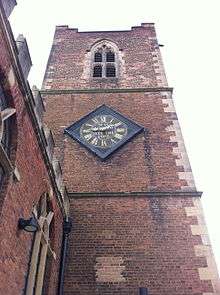St Nicholas' Church, Nottingham
| The Church of St Nicholas | |
|---|---|
|
St. Nicholas' Church Nottingham | |
| Denomination | Church of England |
| Churchmanship | Charismatic Evangelical |
| Website | St Nicholas |
| History | |
| Dedication | St Nicholas |
| Administration | |
| Diocese | Southwell and Nottingham |
| Province | Province of York |
| Clergy | |
| Vicar(s) | Steve Silvester (Rector) |
St. Nicholas' Church, known locally as St Nic's, is an Anglican parish church in Nottingham. The church, since 1953, is Grade II* listed by the Department for Culture, Media & Sport as it is a particularly significant building of more than local interest.
History
St Nicholas' Church is one of the three medieval Christian foundations still existing in Nottingham, the others being St Peter's Church and St Mary's Church.
A church of St Nicholas was erected on the site of the present building in the eleventh or twelfth century. This building was destroyed in 1643[1] during the English Civil War. The Royalists established themselves in the tower of the old church, and bombarded the garrison of the Castle. In 1643 the governor of the castle, Colonel Hutchinson ordered the old church to be completely destroyed and for 28 years - from 1643 to 1671 - there was no Church of St. Nicholas in Nottingham. In 1671 a new church was being constructed with completion in 1678, the church which exists today.
The Marriage, Burial and Baptism Registers begin in 1562. Other documents deeds, indentures, ecclesiastical licences, terriers (or inventories of church property) - date from 1671. The Vestry Books contain accounts of elections and church meetings from 1703 onwards.[1] No burials have taken place in the churchyard since 1881.
List of Rectors
|
|
Parish life
St Nic's is an evangelical parish located in the city centre and draws its congregation from across the city. It is popular with university students.
Organ
The first organ was installed in 1811 and listed in the church inventory among other items, "one organ with rods and curtains, two bassoons and a serpent."[1]
In 2010 the former organ by C. Lloyd and Co.[2] was replaced by an electronic organ from Rodgers.
Organists
- Miss Stretton 1811 - ?
- Miss Dodd c. 1818
- Miss Woolley c. 1825
- William Richardson c. 1837 - 1867 (died 23 April 1867; buried 25 April 1867 at St Nicholas; lived on Angel Row [3])
- Henry Bond 1867 - 1871 - ? (blind; formerly organist of St. James' Church, Standard Hill)
- Miss Spurr c.1878 - 1882 - ?
- Mr W. Seymour 1891 - 1908[4]
- Raymond H. Smith c.1940[5]
- Arthur Smedley 1965 - 1977
- John Churchill 1987-
Clock

An early clock was installed in 1699 by Richard Roe.[6] This was replaced in 1830 by a clock by James Woolley which had previously been in the Nottingham Exchange. The diagonal clock face is thought to have been installed at the same time, and also been from the Exchange. This 1830 clock mechanism was replaced by an electric action clock in the 1970s but the clock face was retained. The James Woolley clock was given to the Nottingham Industrial Museum.
References
- 1 2 3 `The History of St Nicholas` by Thomas A Robinson B.A. (c1960)
- ↑ "Nottinghamshire, Nottingham St. Nicholas, Maid Marian Way". National Pipe Organ Register. Retrieved 18 January 2014.
- ↑ Nottingham Review 26 April 1867
- ↑ "Retirement of W Symour". nottingham Evening Post. Nottingham. 31 January 1908. Retrieved 17 April 2015.
- ↑ Nottingham Evening Post - Tuesday 29 October 1940
- ↑ Beeson, C.F.C. English Church Clocks 1280-1850. Brant Wright Associates Ltd. ISBN 0903512149.
Sources
- Alfred Stapleton, 1905, Churches and Monasteries of Old and New Nottingham
- Keith Train, 1981, Train on Churches; Nottingham
- J Holland Walker M.B.E., F.S.A., F.R.Hist.S, c1930, St. Nicholas' Church Nottingham
External links
- J Holland Walker, St. Nicholas' church, Nottingham, Transactions of the Thoroton Society, XLIV (1940)
- History of the church building
- St. Nic's Church on Google Street View
Coordinates: 52°57′03″N 1°9′4″W / 52.95083°N 1.15111°W
